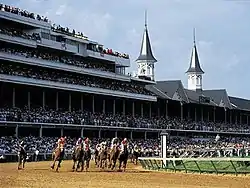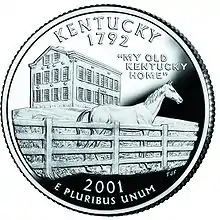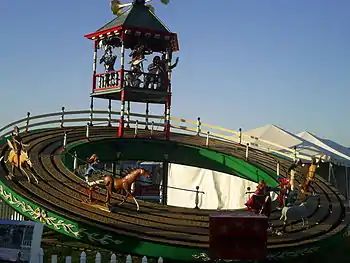Kentucky Derby
The Kentucky Derby /ˈdɜːrbi/ is a horse race held annually in Louisville, Kentucky, United States, almost always on the first Saturday in May, capping the two-week-long Kentucky Derby Festival. The competition is a Grade I stakes race for three-year-old Thoroughbreds at a distance of one and a quarter miles (2.0 km) at Churchill Downs. Colts and geldings carry 126 pounds (57 kilograms) and fillies 121 pounds (55 kilograms).[2]
| Grade I race | |
  The Most Exciting Two Minutes in Sports; The Run for the Roses | |
| Location | Churchill Downs Louisville, Kentucky, United States |
|---|---|
| Inaugurated | 1875 |
| Race type | Thoroughbred |
| Website | www |
| Race information | |
| Distance | 1 1⁄4 miles (10 furlongs; 2 km) |
| Record | 1:59.40, Secretariat (1973, 1 1⁄4 miles) 2:34.50, Spokane (1889, 1 1⁄2 miles) |
| Surface | Dirt |
| Track | Left-handed |
| Qualification | 3-year-old |
| Weight | Colt/Gelding: 126 lbs (57.2 kg) Filly: 121 lb (55 kg) |
| Purse | US $3 million[1] 1st: $1,860,000 |
It is dubbed "The Run for the Roses", stemming from the blanket of roses draped over the winner. It is also known in the United States as "The Most Exciting Two Minutes in Sports" or "The Fastest Two Minutes in Sports" because of its approximate duration. It is the first leg of the American Triple Crown, followed by the Preakness Stakes, and then the Belmont Stakes. Of the three Triple Crown races, the Kentucky Derby had the distinction of having been run uninterrupted for 144 years previous to 2020. The race was rescheduled to September, 2020 due to the COVID-19 pandemic. The Preakness and Belmont Stakes races had taken hiatuses in 1891–1893 and 1911–1912, respectively. Even with the Olympics and major professional sports leagues canceled at those points, the Derby, Preakness, and Belmont took place during the Great Depression and both World Wars.[3]
A horse must win all three races to win the Triple Crown.[4] In the 2015 listing of the International Federation of Horseracing Authorities (IFHA), the Kentucky Derby tied with the Whitney Handicap as the top Grade 1 race in the United States outside the Breeders' Cup races.[5]
The attendance at the Kentucky Derby ranks first in North America and usually surpasses the attendance numbers of all other stakes races including the Preakness Stakes, Belmont Stakes, and the Breeders' Cup.[6]
The 147th Kentucky Derby is scheduled for Saturday, May 1, 2021
History
In 1872, Col. Meriwether Lewis Clark Jr., grandson of William Clark of the Lewis and Clark expedition, traveled to England, visiting Epsom in Surrey where The Derby had been running annually since 1780.[7] From there, Clark went on to Paris, France, where a group of racing enthusiasts had formed the French Jockey Club in 1863. They had organized the Grand Prix de Paris at Longchamp, which at the time was the greatest race in France.

Returning home to Kentucky, Clark organized the Louisville Jockey Club to raise money for building quality racing facilities just outside the city. The track would soon become known as Churchill Downs, named for John and Henry Churchill, who provided the land for the racetrack.[8] The naming went official in 1937.[9]
The Kentucky Derby was first run at 1 1⁄2 miles (12 furlongs; 2.4 km) the same distance as the Epsom Derby, before changing lengths in 1896 to its current 1 1⁄4 miles (10 furlongs; 2 km). On May 17, 1875, in front of an estimated crowd of 10,000 people, a field of 15 three-year-old horses contested the first Derby. Under jockey Oliver Lewis, a colt named Aristides, who was trained by future Hall of Famer Ansel Williamson, won the inaugural Derby. Later that year, Lewis rode Aristides to a second-place finish in the Belmont Stakes.
Although the first race meeting proved a success, the track ran into financial difficulties, and in 1894 the New Louisville Jockey Club was incorporated with the new capitalization and improved facilities. Despite this, the business floundered until 1902 when Col. Matt Winn of Louisville put together a syndicate of businessmen to acquire the facility. Under Winn, Churchill Downs prospered, and the Kentucky Derby then became the preeminent stakes race for three-year-old thoroughbred horses in North America.
Thoroughbred owners began sending their successful Derby horses to compete in two other races. These two are the Preakness Stakes at the Pimlico Race Course, in Baltimore, and the Belmont Stakes in Elmont, New York. The three races offered large purses, and in 1919 Sir Barton became the first horse to win all three races. However, the term Triple Crown didn't come into use for another eleven years. In 1930, when Gallant Fox became the second horse to win all three races, sportswriter Charles Hatton brought the phrase into American usage. Fueled by the media, public interest in the possibility of a "superhorse" that could win the Triple Crown began in the weeks leading up to the Derby. Two years after the term went in use, the race (until that time ran in mid-May since inception) changed the date to the first Saturday in May. This change allows for a specific schedule for the Triple Crown races. Since 1931, the order of Triple Crown races has been the Kentucky Derby first, followed by the Preakness Stakes and then the Belmont Stakes. Before 1931, eleven times the Preakness was run before the Derby. On May 12, 1917, and again on May 13, 1922, the Preakness and the Derby took place on the same day. On eleven occasions the Belmont Stakes was run before the Preakness Stakes.

On May 16, 1925, the first live radio broadcast of the Kentucky Derby aired on WHAS as well as on WGN in Chicago.[10] On May 7, 1949, the first television coverage of the Kentucky Derby took place, produced by WAVE-TV, the NBC affiliate in Louisville. This coverage was aired live in the Louisville market and sent to NBC as a kinescope newsreel recording for national broadcast. On May 3, 1952, the first national television coverage of the Kentucky Derby took place, aired from then-CBS affiliate WHAS-TV.[11] In 1954, the purse exceeded US$100,000 for the first time. In 1968, Dancer's Image became the first horse to win the race and then faced disqualification. A urine test revealed traces of phenylbutazone (an anti-inflammatory painkiller drug) inside Dancer's Image. Forward Pass won after a protracted legal battle by the owners of Dancer's Image (which they lost). Forward Pass thus became the eighth winner for Calumet Farm. Unexpectedly, the regulations at Kentucky thoroughbred race tracks were changed some years later, allowing horses to run on phenylbutazone. In 1970, Diane Crump became the first female jockey to ride in the Derby, finishing 15th aboard Fathom.[12]
The fastest time ever run in the Derby was in 1973 at 1:59.4 minutes, when Secretariat broke the record set by Northern Dancer in 1964 – a record time yet to be topped. Also during that race, he did something unique in Triple Crown races: for each successive quarter ran, his times were faster. Although the races do not record times for non-winners, in 1973 Sham finished second, two and a half lengths behind Secretariat in the same race. Using the thoroughbred racing convention of one length equaling one-fifth of a second to calculate Sham's time, he also finished in under two minutes. Another sub-two-minute finish, only the third, was set in 2001 by Monarchos at 1:59.97.[13]
In 2005, the purse distribution for the Derby changed, so that horses finishing fifth would henceforth receive a share of the purse; previously only the first four finishers did so.[14]
The Kentucky Derby began offering $3 million in purse money in 2019. Churchill Downs officials have cited the success of historical race wagering terminals at their Derby City Gaming facility in Louisville as a factor behind the purse increase.[1] The Derby first offered a $1 million purse in 1996; then doubled to $2 million in 2005.[1]
A new starting gate with twenty stalls was debuted for the 146th Kentucky Derby in 2020. Designed by Australian company, Steriline Racing, the new contiguous gate has replaced the previous method of starting the Derby using a 14-stall main starting gate and a 6-stall auxiliary gate. Churchill officials cited the need for increased horse and rider safety as the reason for selecting Steriline to design and manufacture the new starting gate.[15][16][17]
In 2020, The Kentucky Derby was postponed from May 2 to September 5 due to the COVID-19 pandemic.[18] This is the second time in history the race had been postponed, the other being in 1945.
Attendance
Millions of people from around the world bet at various live tracks and online sportsbooks.[19] In 2017, a crowd of 158,070 watched Always Dreaming win the Derby, making it the seventh biggest attendance in the history of the racetrack. The track reported a wagering total of $209.2 million from all the sources on all the races on the Kentucky Derby Day program. It was a 9 percent increase compared to the total of $192.6 million in 2016 and an increase of 8 percent over the previous record set in 2015 of $194.3 million.[20] TwinSpires, a platform for betting online and a partner of the Kentucky Derby and the Breeders' Cup, recorded $32.8 million in handle on the Churchill Down races for the Kentucky Derby Day program. This record was a 22 percent increase over the preceding year. On the Kentucky Derby race alone, the handle of TwinSpires was $20.1 million, which is a 22 percent rise compared to the prior year.[21]
The race often draws celebrities. HM Queen Elizabeth II, on a visit to the United States, joined the racegoers at Churchill Downs in 2007.[22]
Sponsorship
The 2004 Kentucky Derby marked the first time that jockeys—as a result of a court order—were allowed to wear corporate advertising logos on their clothing.[23][24]
Norman Adams has been the designer of the Kentucky Derby Logo since 2002. On February 1, 2006, the Louisville-based fast-food company Yum! Brands, Inc. announced a corporate sponsorship deal to call the race "The Kentucky Derby presented by Yum! Brands."[25] In 2018, Woodford Reserve replaced Yum Brands as the presenting sponsor.[26]
Traditions
In addition to the race itself, several traditions play a significant role in the Derby atmosphere. The mint julep—an iced drink consisting of bourbon, mint, and sugar syrup—is the traditional beverage of the race. The historic beverage comes served in an ice-frosted silver julep cup. However, most Churchill Downs patrons sip theirs from souvenir glasses (first offered in 1939 and available in revised form each year since) printed with all previous Derby winners.[27] Also, burgoo, a thick stew of beef, chicken, pork, and vegetables, is a popular Kentucky dish served at the Derby.[28]

The infield—a spectator area inside the track—offers general admission prices but little chance of seeing much of the race, particularly before the jumbotron installation in 2014.[29][30] Instead, revelers show up in the infield to party with abandon. By contrast, "Millionaire's Row" refers to the expensive box seats that attract the rich, the famous and the well-connected. Women appear in elegant outfits lavishly accessorized with large, elaborate hats. Following the Call to the Post, as the horses start to parade before the grandstands, the University of Louisville Cardinal Marching Band plays Stephen Foster's "My Old Kentucky Home." This song is a tradition which began in 1921.[31] The event attracts spectators from a large area, flying in hundreds of private aircraft to Louisville International Airport.[32]
The Derby is frequently referred to as "The Run for the Roses", because a lush blanket of 554 red roses is awarded to the Kentucky Derby winner each year. The tradition originated in 1883 when New York City socialite E. Berry Wall presented roses to ladies at a post-Derby party. Churchill Downs founder and president, Col. M. Lewis Clark, attended that event. This gesture is believed to have led Clark to the idea of making the rose the race's official flower. However, it was not until 1896 that any recorded account referred to draping roses on the Derby winner. The Governor of Kentucky awards the garland and the Kentucky Derby Trophy. Pop vocalist Dan Fogelberg composed the song "Run for the Roses", released in time for the 1980 running of the race.[33]
Riders Up!
"Riders Up!" is the traditional command from the Paddock Judge for jockeys to mount their horses in advance of the upcoming race. Since 2012, a dignitary or celebrity attendee recites this phrase.
Festival
In the weeks preceding the race, numerous activities took place for the Kentucky Derby Festival. Thunder Over Louisville—an airshow and fireworks display—generally begins the festivities in earnest two weeks before the Derby.
Records
Speed record:
- Mile and a Quarter: 1:59.4 – Secretariat (1973)
- Mile and a Half: 2:34.5 – Spokane (1889)
Margin of Victory:
- 8 lengths – Old Rosebud (1914), Johnstown (1939), Whirlaway (1941), Assault (1946)
Most wins by a jockey:
- 5 – Eddie Arcaro (1938, 1941, 1945, 1948, 1952)
- 5 – Bill Hartack (1957, 1960, 1962, 1964, 1969)
Most wins by a trainer:
- 6 – Ben A. Jones (1938, 1941, 1944, 1948, 1949, 1952)
- 6 – Bob Baffert (1997, 1998, 2002, 2015, 2018, 2020)
Most wins by an owner:
- 8 – Calumet Farm (1941, 1944, 1948, 1949, 1952, 1957, 1958, 1968)
Longest shot to win the Derby:
- 91 to 1 – Donerail (1913)
Miscellaneous:
- In 2010, Calvin Borel set a new record, being the first jockey to win 3 out of 4 consecutive Kentucky Derbys.[34]
- In 2018, Justify became the first horse since Apollo in 1882, to win the Derby without having raced as a two-year-old.[35]
- In 2019, Country House won the Kentucky Derby after Maximum Security was disqualified.[36][37]
Winners
- Notes
![]() designates a Triple Crown Winner.
designates a Triple Crown Winner.
![]() designates a filly.
designates a filly.
- The race was timed to 1⁄4 second from 1875 to 1905, to 1⁄5 second from 1906 to 2000, and to 0.01 second since 2001.
- Maximum Security crossed the finish line first, but was disqualified for interference.
- Dancer's Image, ridden by Bobby Ussery, trained by Lou Cavalaris Jr., and owned by Peter D. Fuller, finished first, but was disqualified after a post-race urine sample revealed traces of a banned drug in the horse. The drug in question – phenylbutazone – is now legal for use on racehorses in many states, including Kentucky.
- Apollo (1882) was the only horse to have won the Derby without having raced at age two, until Justify in 2018.[39]
See also
- Kentucky Oaks
- Kentucky Derby Festival
- American thoroughbred racing top attended events
- Kentucky Derby top four finishers
- List of graded stakes at Churchill Downs
- "The Kentucky Derby Is Decadent and Depraved", a seminal example of New Journalism by Hunter S. Thompson.
- Triple Crown Productions
- Triple Crown of Thoroughbred Racing
- Grand Slam of Thoroughbred Racing
- List of attractions and events in the Louisville metropolitan area
- Derby Pie
- List of Kentucky Derby broadcasters
References
- Angst, Frank (January 10, 2019). "Kentucky Derby Purse Increased to $3 Million". bloodhorse.com. The Bloodhorse. Archived from the original on January 11, 2019. Retrieved January 10, 2019.
- "Tenth Race Churchill May 1, 2004". May 1, 2004. Daily Racing Forum. Accessed on May 9, 2006.
- https://www.tvg.com/promos/kentucky-derby/kentucky-derby-history.html Archived January 27, 2019, at the Wayback Machine Kentucky Derby History
- Novak, Claire (September 23, 2013). "Will Take Charge Wins Pennsylvania Derby". Blood Horse. Archived from the original on February 23, 2014. Retrieved February 22, 2014.
- "The World's Top 100 G1 Races for 3yo's and upwards" (PDF). www.ifhaonline.org. International Federation of Horseracing Authorities. Retrieved March 3, 2015.
- ^ 2009 The Original Racing Almanac, page 140 for Kentucky Derby, page 156 for the Preakness Stakes, page 241 for Kentucky Oaks, page 167 for Belmont Stakes, page 184 Breeders' Cup, June 26, 2008.
- "Racing for the Roses – History of Kentucky Derby". February 15, 2014. Archived from the original on March 6, 2014. Retrieved February 22, 2014.
- Ward, Arch (April 30, 1936). "Talking It Over". Chicago Tribune. Archived from the original on July 25, 2012. Retrieved May 5, 2012.(subscription required)
- "History Of Churchill Downs". Churchill Downs. Archived from the original on March 1, 2014. Retrieved February 23, 2014.
- "Derby To Go On The Air", The New York Times, May 16, 1925, p. 11
- "Kentucky Derby History". Kentucky Derby Info. Archived from the original on October 29, 2012. Retrieved December 29, 2011.
- McKenzie, Sheena. "Jockey who refused to stay in the kitchen". CNN. Archived from the original on February 2, 2018. Retrieved February 2, 2018.
- Dandrea, Phil (2010). Sham: Great Was Second Best. Acanthus Publishing. Archived from the original on December 1, 2018. Retrieved May 8, 2020.
- "Horse Racing – Kentucky Derby purse doubled to $2 million". ESPN. Archived from the original on May 1, 2018. Retrieved April 30, 2018.
- Hegarty, Matt (February 3, 2020). "Churchill to debut new 20-stall starting gate in 2020 Kentucky Derby". drf.com. Daily Racing Form. Archived from the original on February 3, 2020. Retrieved February 3, 2020.
- Ward, Kelly (February 3, 2020). "Churchill Downs commissions new contiguous starting gate for the 2020 Kentucky Derby". courier-journal.com. The Courier-Journal. Retrieved February 3, 2020.
- Racing, Steriline. "Success at the Kentucky Derby 2020". blog.sterilineracing.com. Retrieved November 10, 2020.
- Casado, Joey Hadden, Laura. "Here are the latest major events that have been canceled or postponed because of the coronavirus outbreak, including the 2020 Tokyo Olympics, the Cannes Film Festival, and the 74th Annual Tony Awards". Business Insider. Archived from the original on March 5, 2020. Retrieved April 2, 2020.
- "Record betting reported on 2017 Kentucky Derby". The Courier-Journal. Retrieved April 4, 2018.
- "How Much Money is Wagered on the Kentucky Derby Each Year?". www.betfirm.com. Archived from the original on April 4, 2018. Retrieved April 4, 2018.
- Finley, Marty (May 9, 2016). "The 2016 Kentucky Derby: By the numbers". bizjournals.com. Archived from the original on March 23, 2017. Retrieved April 4, 2018.
- Hopkins, Andrea. "Kentucky Derby, Queen Elizabeth draw festive crowd". U.S. Archived from the original on May 1, 2018. Retrieved April 30, 2018.
- "Derby jockeys can wear ads". UPI. Archived from the original on May 1, 2018. Retrieved April 30, 2018.
- Green, Marcus. "Jockey advertising at Kentucky tracks remains rare a decade after ruling". Archived from the original on May 1, 2018. Retrieved April 30, 2018.
- Isidore, Chris (May 5, 2006). "Kentucky Derby including Yum Brands in its name". Archived from the original on May 17, 2006. Retrieved May 10, 2010.
- "Woodford Reserve is New Kentucky Derby Sponsor". BloodHorse.com. Archived from the original on April 15, 2018. Retrieved April 15, 2018.
- Sneed, Tierney. "The Origin of Your Favorite Kentucky Derby Traditions". usnews.com. Archived from the original on October 24, 2016. Retrieved July 3, 2016.
- Fred, Smith (May 1, 1961). "Bluegrass, Bourbon and Burgoo". Sports Illustrated – Vault. Archived from the original on October 27, 2018. Retrieved October 26, 2018.
- "Giant screen at Churchill Downs gives everyone at Kentucky Derby a front-row view". kentucky. Archived from the original on May 1, 2018. Retrieved April 30, 2018.
- "Panasonic Announces Installation of World's Largest 4K Video Board at Churchill Downs | | Churchill Downs Racetrack | Home of the Kentucky Derby". www.churchilldowns.com. Archived from the original on May 1, 2018. Retrieved April 30, 2018.
- "My Old Kentucky Home". Archived from the original on May 3, 2013. Retrieved April 29, 2013.
- Epstein, Curt (May 5, 2015). "Derby, Boxing Match Fuel Atlantic's Best Day Ever". Aviation International News. Archived from the original on May 9, 2015. Retrieved May 6, 2015.
- "Dan Fogelberg Prodigy Chat transcript Treehouse.org". Retrieved October 16, 2014.
- "Super Saver wins the 2010 Kentucky Derby – Kentucky Derby". archive.org. Archived from the original on May 14, 2010.
- Mellisa Hoppert (May 6, 2018). "Justify Wins Kentucky Derby, Conquering Rain, Mud and a 136-Year Curse". The New York Times. Archived from the original on May 6, 2018. Retrieved May 6, 2018.
- Drape, Joe (May 4, 2019). "Country House Wins Kentucky Derby After Maximum Security Is Disqualified". The New York Times. Retrieved May 5, 2019.
- Writer, BETH HARRIS AP Racing. "Kentucky Derby shocker: Country House wins via DQ". Richmond Times-Dispatch. Archived from the original on May 5, 2019. Retrieved May 5, 2019.
- "Kentucky Derby Winners". www.kentuckyderby.com. Archived from the original on August 4, 2016. Retrieved July 3, 2016.
- Hoppert, Melissa. "Justify Wins Kentucky Derby, Conquering Rain, Mud and a 136-Year Curse". New York Times. Archived from the original on May 6, 2018. Retrieved May 5, 2018.
Further reading
- David Domine, Insiders' Guide to Louisville. Guilford, Connecticut: Globe-Pequot Press, 2010.
- James C. Nicholson, The Kentucky Derby: How the Run for the Roses Became America's Premier Sporting Event. Lexington, Kentucky: University Press of Kentucky, 2012.
External links
- Kentucky Derby (official site)
- Kentucky Derby Museum
- The Courier-Journal's Derby Site
- The History of The Kentucky Derby
- ESPN.COM Attending the Kentucky Derby (includes future dates)
 The dictionary definition of run for the roses at Wiktionary
The dictionary definition of run for the roses at Wiktionary Media related to The Kentucky Derby at Wikimedia Commons
Media related to The Kentucky Derby at Wikimedia Commons- Kentucky Derby News
